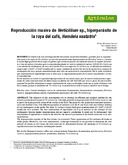Reproducción masiva de Verticillium sp., hiperparásito de la roya del café, Hemileia vastatrix
Alternative title
Massive reproduction of Verticillium sp., Hemileia vastatrix hyperparasitic
Description
2 ilus. 2 tab. 29 referencias bibliográficas
Abstract
El objetivo de esta investigación fue desarrollar un método eficiente y práctico para la reproducción masiva de cepas de Verticillium sp. con alto potencial como hiperparásitos de Hemileia vastatrix y probar la acción hiperparasítica de las cepas en plantas que crecen en macetas en ambiente natural. Se empleó un sustrato a base de melaza y levadura para la reproducción, donde se varió la cantidad de melaza (120, 80, 40 y 8 g/l), con y sin adición de uredosporas de roya en el medio. Para tres cepas de Verticillium sp., se alcanzaron concentraciones entre 2.3x106 y 5.5x109 conidias/ml. La mejor cantidad de melaza fue de 8 g de melaza/l en ausencia de uredosporas de roya, porque concentraciones más altas no mejoraron la reproducción. No se pudo establecer qué combinación de ingredientes sería la ideal para la reproducción masiva de la cuarta cepa, debido a su lenta reproducción. En las macetas se evaluó la capacidad hiperparasítica de las cuatro cepas, para lo cual se realizaron tres asperciones de cinco combinaciones de dichas cepas en plantas de café afectadas por roya. A pesar de que estadísticamente fue posible determinar la mejor combinación de cepas, en términos reales no se pudo establecer cuál fue la mejor, porque la incidencia de Verticillium sp. se generalizó en todo el ensayo, inclusive en el testigo. The objective of this investigation was to develop an efficient and practical method for the massive production of strains of Verticillium sp. with high potential as hyperparasites of Hemileia vastatrix and to prove the hyperparasitic action of the strains in the field. The media for the production contained molasses, yeast and distilled water, with different quantities of molasses (120, 80, 40 and 8 g/l), with and without addition of rust uredospores in the media. For three Verticillium strains, final spore concentrations of 2.3x106 y 5.5x109 conidia/ml were reached. The best combination of ingredients was 8 g of melaza/l in the absence of rust uredospores because higher concentrations did not improve production. It could not be determined what combination of ingredients it would be the ideal for the massive production of the fourth strain due to its slow reproduction. The hyperparasitic capacity of the four strains was evaluated. Three applications of five mixtures of strains in coffee plants affected by rust were administered. Although statistically it was possible to determine the best mixture of strains, in real terms, the best could not be determined because the incidence of Verticillium sp. equilibrated across treatments, including the control.
Keywords
Publisher
CATIE, Turrialba (Costa Rica)
URI (Permanet link to cite or share this item)
https://repositorio.catie.ac.cr/handle/11554/6776Collections
- Publicaciones y documentos [3628]


